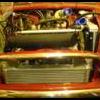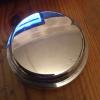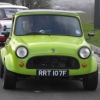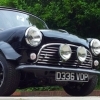Thanks to Geehawk for finding it.
Technobabble: September 1999
Scrub Radius and the Dave Point
By Dave Coleman
I've been told that in the mountains of Alaska there are grand majestic peaks that don't even have names. That's hard to imagine living down here in the lower 48, geographic features as unexciting as freeway overpasses are often named after some great overpass luminary. The same is true of science and engineering, where designs, mechanisms, and even equations are named after those who figured them out first. A solid axle rear suspension, for example, typically has either a Watts linkage or Panhard rod, unless it's a new Nissan, in which case it will have a Scott-Russel link. (I guess it took two people to figure that one out) It is really a combination of skill and luck to have some mechanism bear your name, after all, a Panhard rod is hardly a stroke of genius, but Panhard must have been an opportunistic little bugger to tack his name to a simple little bar.
I've never really felt any desire to have a linkage, or a bar, or a pivot named after me, but an opportunity just came up and I had to take it. You see, I was trying to figure out the best way to explain what causes torque steer (which is really supposed to be the point of this story, but I'll get to that in a minute) and I couldn't find a name for the point where the steering axis intersects the ground. Without a name, I had to continually refer to it as the point where the steering axis intersects the ground. So I write about the point where the steering axis intersects the ground this, and the point where the steering axis intersects the ground that, and pretty soon I realize there is an opportunity here. I could save myself a lot of grief and ensure eternal fame by simply naming the point after myself. So from this day forth, I declare the point where the steering axis intersects the ground to be the Dave Point.
So back to torque steer. First, what is it and why do you care? Torque steer is simply the tendency of a front-wheel drive car to try to steer itself when you are accelerating. Why do you care? If you are like me (except you don't have a point named after yourself) torque steer really pisses you off, and while understanding where it comes from won't make it *yellow human water* you off any less, it may give you something to think about while you're fuming. The cause of torque steer is really quite simple.
When you turn the steering wheel, it turns about an axis that is, surprisingly enough, called the steering axis. (I told you this was simple.) As with anything that turns about an axis, if you push on it, it will probably turn. The simplest example is a door; it rotates about hinge, and if you push on it, it will rotate.
So what's pushing on the wheel? You and your right foot, actually. The engine's torque output moves the car by pushing on it right at the contact patch between the tire and the ground. When the tire is sitting flat on the ground, that contact patch is basically a rectangle, and you can assume that all the force is being applied right in the middle of it. Now, the Dave Point (remember, this is the point where the steering axis hits the ground) is the point that the contact patch rotates about, so if the Dave Point is also in the middle of the contact patch, the car can simply accelerate in a straight line. If you try to open a door by pushing on the hinge pin, you won't go anywhere. Similarly, if the Dave Point is right in the middle of the tire, the car should accelerate in a straight line.
Of course, as you have probably guessed, it is very difficult to put the Dave Point in the middle of the tire. The steering axis, on cars with MacPherson strut front suspensions (like Nissan Sentras, Subaru Imprezas, and just about anything cheap), is defined by the line that connects the top of the strut and the lower ball joint. Since the strut can't pass through the middle of the tire, and the ball joint has to battle with the brake rotor for real estate, it is quite difficult to get the Dave Point into the middle of the tire. Other suspensions define the steering axis different ways, but virtually all of them present some sort of challenge to proper Dave Point placement.
In most cases, the Dave Point is slightly inboard and slightly in front of the center of the contact patch. The distance between these two points is called the scrub radius because it defines how far the contact patch has to be scrubbed across the pavement when the steering wheel is turned. Now, if you push on the tire at middle of the contact patch, and the Dave Point is off to the side somewhere, the tire will try to steer around the Dave Point. The higher the scrub radius, the more steering torque will be generated, and the more pissed off you will be.
Now, those of you who are really on the ball have probably already picked up on this next fact. In most cases--pay attention here--there are two front wheels, and unless something has gone horribly wrong, the suspension geometry on one side is a mirror image of the other side. So while the right wheel tries to turn left, the left wheel tries to turn right, and they cancel each other out and go straight. Unfortunately, in the real world, that seldom works out.
The contact patch, you see, is a dynamic thing. It flexes and bends over uneven surfaces, and if there is an imperfection in the road, the center of the contact patch will move, and the steering torque on each side of the car will no longer cancel out. The same can happen if one wheel has less traction than the other. If one wheel is pushing with more force, it will exert more steering effort, and you will get pissed off.
There is very little that you, as a non-car manufacturer, can do to reduce torque steer, but there are things you can do to make it worse (or not do to not make it worse). Wider tires have wider contact patches, and therefore more latitude for the scrub radius to move around when you encounter uneven surfaces. Low profile tires with stiff sidewalls are less willing to conform to those surfaces, and so can actually move the patch around even more. Having the wrong offset on your wheels can increase the scrub radius by moving the contact patch. Even extreme alignment settings can increase the scrub radius by moving the Dave Point around.
All of these things you want to avoid are things that make your car handle better, so you have to decide which is more important, reducing torque steer or handling well. Duh! Live with the torque steer. Here's a solution: keep both hands on the wheel.


















